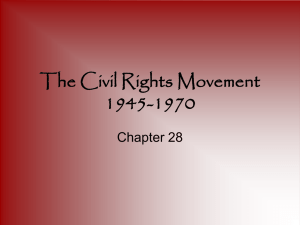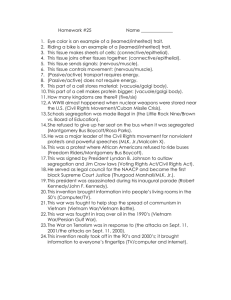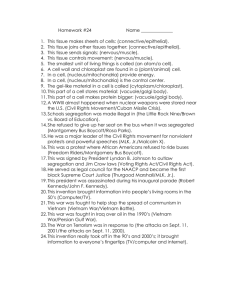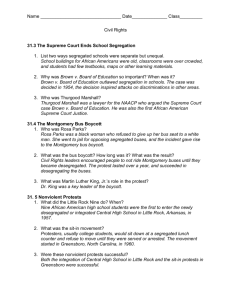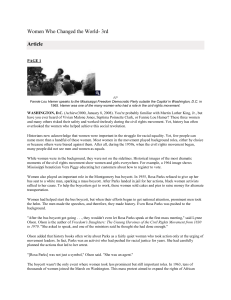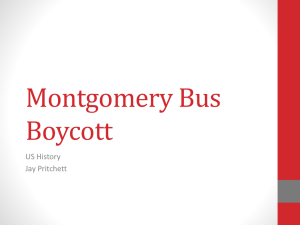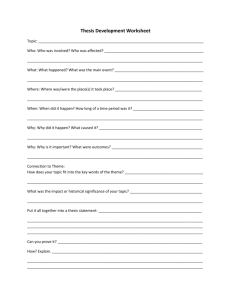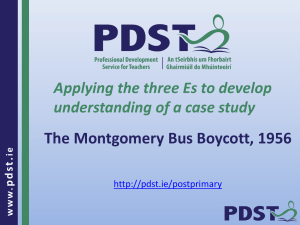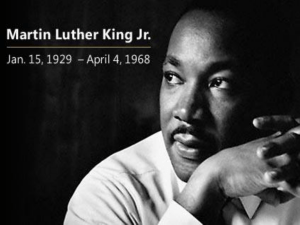The Montgomery Bus Boycott & Rosa Parks 1955–1956 The
advertisement
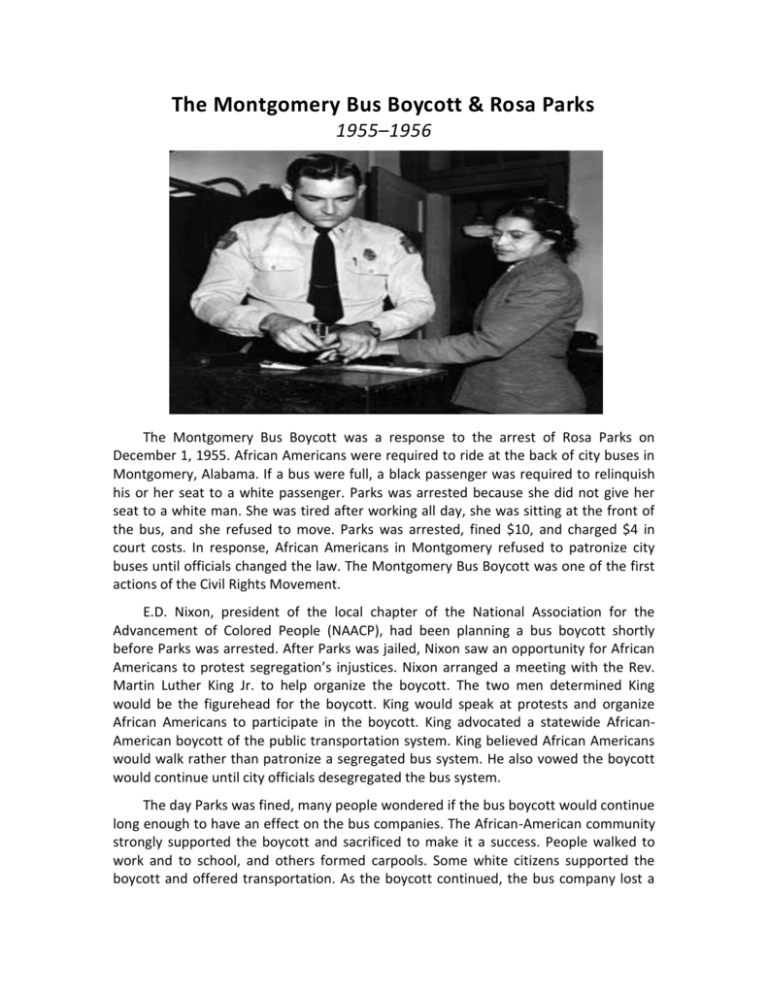
The Montgomery Bus Boycott & Rosa Parks 1955–1956 The Montgomery Bus Boycott was a response to the arrest of Rosa Parks on December 1, 1955. African Americans were required to ride at the back of city buses in Montgomery, Alabama. If a bus were full, a black passenger was required to relinquish his or her seat to a white passenger. Parks was arrested because she did not give her seat to a white man. She was tired after working all day, she was sitting at the front of the bus, and she refused to move. Parks was arrested, fined $10, and charged $4 in court costs. In response, African Americans in Montgomery refused to patronize city buses until officials changed the law. The Montgomery Bus Boycott was one of the first actions of the Civil Rights Movement. E.D. Nixon, president of the local chapter of the National Association for the Advancement of Colored People (NAACP), had been planning a bus boycott shortly before Parks was arrested. After Parks was jailed, Nixon saw an opportunity for African Americans to protest segregation’s injustices. Nixon arranged a meeting with the Rev. Martin Luther King Jr. to help organize the boycott. The two men determined King would be the figurehead for the boycott. King would speak at protests and organize African Americans to participate in the boycott. King advocated a statewide AfricanAmerican boycott of the public transportation system. King believed African Americans would walk rather than patronize a segregated bus system. He also vowed the boycott would continue until city officials desegregated the bus system. The day Parks was fined, many people wondered if the bus boycott would continue long enough to have an effect on the bus companies. The African-American community strongly supported the boycott and sacrificed to make it a success. People walked to work and to school, and others formed carpools. Some white citizens supported the boycott and offered transportation. As the boycott continued, the bus company lost a significant amount of money. Officials in Montgomery pressured insurance agencies to stop providing insurance for vehicles used for carpooling. Determined African Americans found other insurance companies that would insure their automobiles. African Americans who owned taxicabs charged ten cents a fare, the same amount African Americans paid for taking the bus. City officials opposed this idea. They claimed the taxi business would lose money. They also required that the minimum price a taxicab should charge forty-five cents. Drivers charging anything lower would be fined. Local churches supported the boycott with special church collections. Eager to help the movement, the majority of African Americans donated to the cause. During this time there was anti-African American sentiment. Some white people joined groups such as the Ku Klux Klan. King’s home and four African-American churches were firebombed. This illustrated the hatred some whites had for African Americans. King also was arrested, along with one hundred fifty-five other protesters during one of the bus boycotts. King spent two weeks in jail. This helped to draw national attention to the boycott, and the actions in Montgomery infuriated African Americans in other parts of the United States. On June 4, 1956, a federal district court ruled that the regulations in Montgomery regarding the segregation of public transportation were unconstitutional. Nevertheless, no enforcement order had been passed down, so the boycott continued. The case went to the U.S. Supreme Court. It ruled on November 13, 1956, that the bus laws were not legal. African Americans were now free to sit wherever they wanted on the bus and other forms of public transportation. The Montgomery Bus Boycott ended on December 20, 1956. After completing the Guided Reading, answer the following questions. Be sure to include textual evidence to support your responses. 1. Why did African Americans begin the Montgomery Bus Boycott? 2. Who planned the bus boycott? 3. Who was the figurehead of the boycott? When did he say the boycott would be lifted? 4. What attacks did African Americans suffer during the bus boycott? 5. What brought national attention to the bus boycott? 6. What ended the Montgomery Bus Boycott? After completing the Guided Reading, answer the following questions. Be sure to include textual evidence to support your responses. 1. Why did African Americans begin the Montgomery Bus Boycott? The protest started after Rosa Parks was arrested on December 1, 1955. She refused to give up her seat to a white man while riding a bus following a long day of work. Parks, weary and tired from work, did not give up her seat in the front. Parks was found guilty four days later. She was charged a $10 fine, plus $4 in court costs. 2. Who planned the bus boycott? E.D. Nixon, the president of the local chapter of the National Association for the Advancement of Colored People (NAACP), had been planning a bus boycott shortly before Parks was arrested. After Parks was jailed, Nixon saw this as just cause for African Americans in the area to protest the injustices of segregation. 3. Who was the figurehead of the boycott? When did he say the boycott would be lifted? The Rev. Martin Luther King Jr. was the figurehead of the boycott. King spoke at protests and organized African Americans for the cause. King stated that African Americans would commit to a statewide boycott of the public transportation system. King said African Americans would rather walk than ride a segregated bus system. He also said the boycott would last until legislation desegregating the bus system was enacted. 4. What attacks did African Americans suffer during the bus boycott? Martin Luther King’s home and four African-American churches were firebombed. 5. What brought national attention to the bus boycott? King and one hundred fifty-five other protesters were arrested. King spent two weeks in jail. This brought national attention to the bus boycott because the actions in Montgomery infuriated African Americans in other parts of the United States. 6. What ended the Montgomery Bus Boycott? On June 4, 1956, a federal district court stated the rules and regulations in Montgomery regarding the segregation of public transportation were unconstitutional. However, no legislation was passed, so the boycott continued. The case went to the U.S. Supreme Court, which ruled on November 13, 1956, that the regulations were illegal. African Americans were now free to sit wherever they wanted on buses and other forms of public transportation. The bus boycott ended on December 20, 1956.
